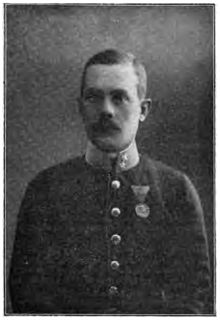Franz Mannsbarth
Franz Mannsbarth (born November 22, 1877 in Iglau , Moravia ; † October 2, 1950 in Payerbach , Lower Austria ) was an Austrian aviation pioneer .
Life
Franz Mannsbarth was born in 1877 as the son of a regimental doctor. Since he lost his parents at an early age, he grew up in the Bad Fischau Officer's Orphan Institute . After completing secondary school in Vienna, he was retired in 1896 as deputy cadet officer in the 53rd Infantry Regiment in Agram . In 1897 he was promoted to lieutenant and in 1901 to first lieutenant. From 1906 he served as a free balloon pilot and expert in aviation matters in the airship department of the 49th Infantry Regiment. As a delegate to Austria-Hungary , he attended the " International Airship Exhibition Frankfurt 1909 ", during which he was among 51 competitors in the free balloon flight competition on the route Zurich - Pilsen Winner emerged and thus acquired the "diploma as an international free balloon guide".
Together with the engineer Hans Otto Stagl, he built the so-called Stagl-Mannsbarth airship, financed from private funds, which was superior to the zeppelins of the time in terms of size, speed, agility, maneuverability and cost efficiency. Despite numerous successful test flights from the spring of 1911, the Austro-Hungarian Army Administration refused to buy the aircraft, so that in 1914 Stagl and Mannsbarth were forced to dismantle their construction and sell the individual parts. He received the Military Merit Medal from Emperor Franz Joseph . With Theodor Scheimpflug , he made numerous trips up the hill for the purpose of creating maps.
During the First World War , Mannsbarth commanded the airship replacement troops and carried out several reconnaissance flights himself. In 1917 he suffered an injury in the Carpathian Mountains , so that for the time being he could no longer balloon and worked as a major in the Army High Command until the end of the war . He was awarded the Officer's Cross of the Franz Joseph Order . In 1917 he was supposed to develop naval airships, but the end of the war ended this project.
In 1920 he was promoted to lieutenant colonel, but retired from the army in 1921. Then he worked in industry. Among other things, he was Vice President of the Austrian Aero Club . As an expert he was also present when Bruno Marek and Josef Emmer developed their balloons. His wife Hedwig was also a balloonist. In 1929 she was the only woman to obtain a balloon license between the world wars.
After the Second World War he was Vice President of the Aero Club. Franz Mannsbarth died on October 2nd, 1950 in Payerbach, Lower Austria. He was buried in an honorary grave (Group 12 E, Row 2, No. 22) in the Vienna Central Cemetery , where his wife, who died in 1974, also found her final resting place.
Posthumous awards
- 1950: Burial in an honorary grave at the Vienna Central Cemetery .
- In 1964, Mannsbarthgasse in Vienna- Donaustadt (22nd district) was named after him.
Web links
- Mannsbarth, Franz. In: Austria Forum - The Austrian Knowledge Network. Graz University of Technology , November 13, 2010, accessed on February 13, 2011 .
- Mannsbarth Franz. In: Austrian Biographical Lexicon 1815–1950 (ÖBL). Volume 6, Verlag der Österreichischen Akademie der Wissenschaften, Vienna 1975,ISBN 3-7001-0128-7, p. 58.
Individual evidence
- ↑ Reinhard Keimel : Aircraft construction in Austria: from the beginnings to the present . Aviatic, 2003, ISBN 3-925505-78-4 , pp. 40 .
- ↑ cf. Rear gondola of the Austrian airship Stagl Mannsbarth. In: Pictokondotnet. Thomas and Hans-Jürgen Jacob, December 4, 2010, accessed February 13, 2011 .
- ↑ Hedwig Abraham: Mannsbarth 12 E. In: Art and culture in Vienna. Retrieved February 13, 2011 .
| personal data | |
|---|---|
| SURNAME | Mannsbarth, Franz |
| BRIEF DESCRIPTION | Austrian aviation pioneer |
| DATE OF BIRTH | November 22, 1877 |
| PLACE OF BIRTH | Iglau |
| DATE OF DEATH | October 2, 1950 |
| Place of death | Payerbach |

